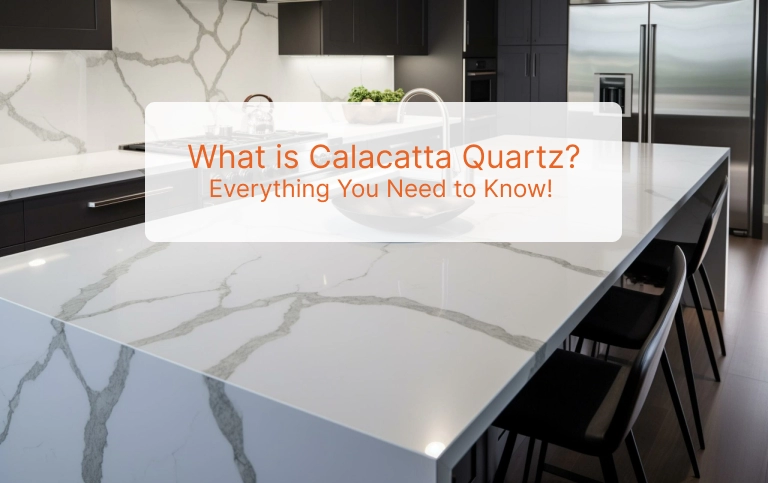The Origins of Calacatta Marble
Calacatta marble is born deep in the Apuan Alps of Carrara, Italy—a region world-renowned for its stunning white marble. This stone forms over millions of years through intense geological processes that create its signature bright white base with unique, bold veins. Its crystalline purity gives Calacatta a luxurious, almost luminous appearance that’s hard to match.
Historically, Calacatta marble has played a starring role in art and architecture. Michelangelo famously sculpted his masterpieces, like David, from Carrara marble, a close cousin of Calacatta. During the Renaissance, this marble graced grand cathedrals and palaces across Italy, symbolizing wealth and exquisite craftsmanship.
What makes Calacatta especially rare is its limited availability. Only a few quarries, such as the exclusive Borghini quarry, produce authentic Calacatta slabs. These quarries’ selective extraction methods ensure the highest quality but also contribute to the stone’s premium status.
Today, modern sourcing respects both tradition and sustainability. Many suppliers maintain direct partnerships with Italian quarries, emphasizing ethical quarrying practices. This guarantees you’re getting authentic Calacatta marble that supports responsible mining and preserves the legacy of this timeless stone.
Identifying Calacatta Stone

Calacatta stone is known for its bright white base paired with bold, dramatic veins in shades of gray, gold, and taupe. These striking vein patterns are what set Calacatta apart from other marbles and give it that luxurious look.
Variations of Calacatta
- Calacatta Classic: Features thick, irregular gray veins with occasional gold streaks.
- Calacatta Gold: Known for its warm, golden veining that adds a rich tone.
- Calacatta Borghini: The rarest type, with intense veining and higher contrast.
Surface Finishes
You’ll find Calacatta in various finishes depending on your style and use:
- Polished: Glossy, shiny surface that highlights color and veins.
- Honed: Matte finish with a silky feel, less reflective but elegant.
- Leathered: Textured surface that adds depth and hides fingerprints.
Natural vs Engineered
Every Calacatta slab is unique, with natural imperfections like minor fissures or spots that give it character. This natural variation is a big reason why Calacatta stone is highly prized—no two slabs look alike.
Spotting Fake Calacatta
Be cautious of imitations or engineered stones marketed as genuine Calacatta. Here are quick tips to tell the real deal:
- Vein Boldness: Genuine Calacatta has bold, natural-looking veins. Fakes often have repetitive or overly uniform patterns.
- Translucency: Real Calacatta lets some light pass through it, adding depth. Engineered alternatives tend to look flat.
Knowing these key features will help you pick authentic Calacatta stone for your next project.
Calacatta vs Competition
When choosing Calacatta stone, it helps to know how it stacks up against other popular options:
| Feature | Calacatta Marble | Carrara Marble | Statuario Marble | Engineered Quartz / Sintered Stone |
|---|---|---|---|---|
| Color Base | Bright white | Softer white to grayish | Bright white | Various colors, often uniform |
| Veining | Bold, dramatic gray, gold, taupe | Fine, feather-like gray veins | Warmer, softer veins | Patterned or solid, often repetitive |
| Luxury Feel | High-end, striking contrast | Classic, subtle elegance | Soft, refined luxury | Durable, low-maintenance but less natural |
| Porosity & Maintenance | Porous, needs regular sealing | More porous, prone to staining | Similar to Calacatta | Non-porous, easy to clean |
| Authenticity | Natural stone with unique patterns | Natural stone but more common | Rare, premium natural stone | Man-made, consistent appearance |
| Use & Traffic Suitability | Best for low to moderate traffic | Good for moderate traffic | Best in design-focused spaces | High-traffic suitable |
| Market Availability US | Limited, premium importers | Wide availability | Scarcer, premium pricing | Widely available |
Quick Tips for Choosing Materials
- For Show-Stopping Looks: Go with Calacatta for its bold veins and bright white base.
- Classic, Budget-Friendly Natural Stone: Carrara offers beauty with more availability.
- Soft Luxury & Warmth: Statuario is your go-to for subtle elegance.
- Durable, Low-Maintenance Needs: Engineered quartz or sintered stone work best for heavy use.
Where to Find Calacatta in the US
Calacatta stone is imported mainly from Italy, often sourced directly from quarries like Borghini near Carrara. Trusted US suppliers have strong partnerships ensuring authenticity and ethical quarrying. While Australian and European markets also have access, the US has some of the most reputable importers specializing in premium Calacatta slabs.
Choosing Calacatta means investing in natural beauty with a story—just be sure it fits your lifestyle and usage needs.
Practical Applications of Calacatta Stone
Calacatta stone is a top choice for a range of spaces thanks to its striking look and durability. Here’s where it really shines:
Kitchens
- Countertops and backsplashes: The bright white base with bold veins creates a stunning focal point. Pair it with matte black or brass fixtures for a modern yet timeless look.
- Use thicker slabs for durability and make sure to seal regularly to protect against stains.
Bathrooms
- Vanity tops and shower walls: Calacatta adds a calming luxury feel here. Its natural patterns bring elegant texture without overwhelming the space.
- Keep the look fresh with polished or honed finishes, depending on the style.
Flooring & Walls
- Great for feature walls or dramatic flooring, particularly in entryways or large living areas.
- Outdoor cladding is possible but requires proper sealing and maintenance to protect from weathering.
Commercial Spaces
- Popular in hotel lobbies and office receptions to make an impactful first impression. It exudes luxury and professionalism.
- Real projects like those by Quanzhou APEX show how Calacatta stone can elevate sophisticated design in high-traffic areas when properly installed and maintained.
Using Calacatta stone thoughtfully brings timeless beauty and a high-end feel to any space — just make sure to prep for upkeep and sealing to keep it looking great for years.
Durability, Care, and Maintenance of Calacatta Stone

Calacatta stone is known for its dense composition, which gives it good scratch resistance compared to other natural stones. However, it’s still porous, so sealing is important to protect it from stains and damage. For most homeowners, sealing your Calacatta marble every 6 to 12 months is enough to keep it looking fresh and guard against spills.
Protecting Your Calacatta Stone
- Use pH-neutral cleaners to avoid acid etching, which can dull or damage the surface.
- Wipe up spills quickly, especially acidic substances like lemon juice, wine, or vinegar.
- Avoid abrasive cleaners or harsh scrubbing pads that harm the polished finish.
Sealing and Stain Removal Tips
- Clean the surface thoroughly before sealing.
- Apply a high-quality penetrating sealer designed for marble.
- Let the sealer absorb fully, then buff off any excess.
- For stubborn stains, use a poultice paste made for natural stone.
Sustainability and Ethical Quarrying
Many modern quarries in Italy follow sustainable practices, limiting environmental impact and supporting ethical labor. When sourcing Calacatta from trusted suppliers with direct Italian partnerships, you promote responsible stone production.
Impact on Property Value
Installing genuine Calacatta stone can elevate your home’s appeal and resale value. Its timeless luxury signals premium quality, making it a smart long-term investment for kitchens, bathrooms, and high-traffic areas. Proper care ensures this beauty lasts for decades, maintaining both style and substance.
Cost of Calacatta Stone
Calacatta stone typically runs between $150 and $300 per square foot installed, depending on the quality, slab thickness, and vein patterns. Since it’s a rare and premium natural stone, expect prices on the higher end if you want slabs with dramatic veining like Calacatta Gold or Borghini.
What affects pricing?
- Import fees: Shipping from Italy adds to the cost.
- Fabrication: Cutting, polishing, and custom finishes influence the final price.
- Rarity: Limited quarries, like those in Carrara, keep supply low and prices up.
- Slab quality: Cleaner slabs with bold veins cost more.
Watch out for low-cost imports
If a deal seems too good to be true, it probably is. Cheap imports often mean lower-quality marble or engineered stones passed off as real Calacatta. To avoid surprises:
- Choose suppliers with direct Italian partnerships.
- Ask for slab origin and certification.
- Avoid vendors without good reviews or clear sourcing info.
Long-term value
Though it’s an upfront investment, Calacatta stone adds real value to your property. Its timeless elegance and durability make it a smart choice for homeowners who want ROI benefits, especially in kitchens and bathrooms that boost resale appeal.
Post time: Nov-27-2025
